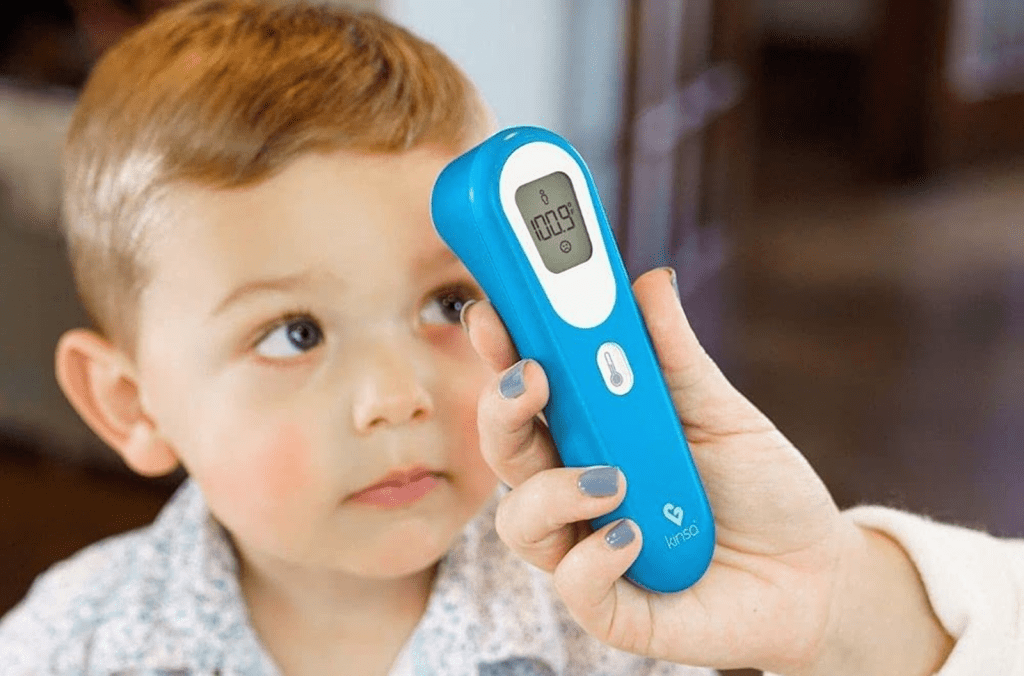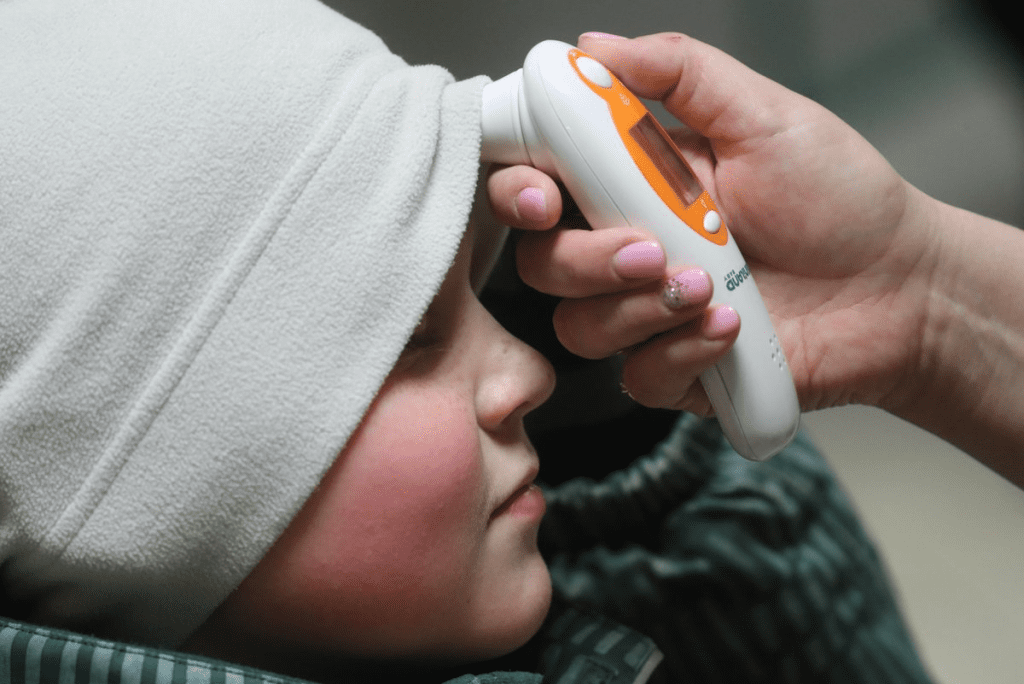Last Updated on November 14, 2025 by
A forehead thermometer is popular because it’s easy to use and noninvasive. Forehead thermometers measure body temperature with infrared sensors, making them a fast and convenient choice for doctors and parents.

But their accuracy is a big worry. Studies have found that these thermometers can miss almost 30% of fevers. This is compared to the usual way of measuring body temperature.
Things like the environment and how you use the thermometer can change how well it works.
The accuracy of forehead thermometers is very important. This is because doctors need to make important decisions based on these readings.
Forehead thermometers are loved for their non-contact method and fast readings. They are easy to use, quick, and comfortable. This makes them great for kids and big groups.
Forehead thermometers are popular because they don’t touch you. This is a big plus for taking kids’ temperatures or for people who don’t like being touched. The best forehead thermometers give fast and easy readings without any pain.
These thermometers are fast, giving you your temperature in seconds. This speed is perfect for busy doctors’ offices and big screenings.
Forehead thermometers are also very comfortable. They’re soft and don’t hurt like some other thermometers. This makes them perfect for kids and people who need to check their temperature often. When looking for the best children’s thermometers, forehead ones are often the first choice because they’re easy and don’t hurt.
In short, forehead thermometers are popular because they’re easy, fast, and comfortable. They’re great for personal use or in hospitals. They’re a smart way to check temperatures.
Clinical studies have shown that forehead thermometers are not always accurate. They are popular because they are easy to use, but their readings can vary. This makes them less reliable than other methods.

Research found that forehead thermometers can miss up to 30% of fevers. This is a big problem for both doctors and at home. It can cause delays in treatment and make things worse for patients.
Key findings from clinical studies include:
Forehead thermometers give readings that can vary by 0.19 °C to 0.34 °C. This small range can be very important in medical decisions. It’s key when you need to know the exact temperature.
The implications of this variation include:
The limits of agreement for forehead thermometers range from -0.58 °C to +0.97 °C. This wide range shows a big difference between the actual body temperature and what the thermometer says.
Understanding these limits is key for:
Knowing what affects forehead thermometer accuracy is key for accurate temperature checks. These thermometers are popular because they’re easy to use and don’t hurt. But, their readings can be off due to several things.
The weather around you can change how well a forehead thermometer works. Temperature and humidity levels matter a lot. For example, very hot or cold weather, or too much humidity, can mess with the thermometer’s accuracy.
The type and quality of the thermometer also play a part. Some thermometers are more precise than others. And some might be more affected by the environment. It’s best to pick a high-quality thermometer from a trusted brand for the most accurate readings.
How you use the thermometer is also very important. Learning the right way to use it is key for getting accurate results. If you don’t use it correctly, like holding it wrong, you might get wrong readings.
Some health issues can also mess with the thermometer’s accuracy. For instance, sweating can change your skin’s temperature, making the reading wrong. Also, some medicines can affect your body’s temperature, making it harder to get an accurate reading.
To get accurate readings, it’s important to think about these factors and find ways to reduce their impact. For more info on thermometer accuracy, check out Medical News Today.
By understanding and dealing with these factors, you can make your forehead thermometer readings more accurate. This helps you make better health decisions.
It’s important to know how accurate different thermometers are. Forehead thermometers are popular because they’re easy to use. But how do they stack up against other types?
Oral thermometers have been around for a long time. They can be very accurate if used correctly. But eating or drinking can mess with their readings. Forehead thermometers are a better choice because they are not affected by these things.
“Oral temperature measurement is considered reliable, but it requires cooperation from the patient and can be influenced by various factors,” according to a study on thermometer accuracy.
Ear thermometers quickly give you the temperature of the eardrum. They’re great for kids because they’re easy to use. But, how well they work depends on who’s using them and if there’s earwax. Forehead thermometers have their own set of pros and cons when compared to ear thermometers.
It’s noted that “ear thermometers are generally accurate, but proper technique is essential to obtain reliable readings.”
Rectal thermometers are the top choice in hospitals, mainly for babies and toddlers. They give you the body’s core temperature, which is very trustworthy. But, they’re not as comfortable for patients. Forehead thermometers are a better option because they’re less invasive, even if they’re not as accurate.
Key advantages of rectal thermometers include:
Axillary thermometers measure the armpit temperature and are easy to use. But, they’re not as accurate as other methods. This is because the armpit temperature can change with the environment. Forehead thermometers are often more reliable in some cases.
A study found that “axillary temperatures are often lower than core body temperatures, making them less reliable for critical measurements.”
Forehead thermometers work well when used correctly. There are ways to make them more accurate. By using these tips, you can trust your forehead thermometer to give you good readings.
Following the maker’s instructions is key to accurate readings. Reading the manual and knowing how to use it is important. This helps avoid mistakes and keeps the thermometer working right.
The thermometer’s distance and how it’s held matter a lot. Keep it at the right distance and aim for the forehead’s center. Some thermometers need a specific angle, so check the manual for this.
Using the neck for readings can be better. A study showed a 91% success rate with the neck. It’s good for some cases, but always check the manual for neck use.
Letting the thermometer adjust to room temperature helps too. Big temperature differences can mess up readings. So, let it get used to the room’s temperature for better results.
By using these tips, you can make your forehead thermometer more accurate. Whether it’s following the manual, using the right techniques, or trying the neck site, there are many ways to improve your thermometer’s performance.
Forehead thermometers are popular, but it’s key to know when to trust them. They are quick and easy to use. Yet, their accuracy can change based on several things.
When someone has a high fever, it’s important to check the forehead thermometer with another method. High fevers can mean serious illness. For adults, using oral or rectal thermometers can give a more reliable reading when a high fever is suspected.
For kids and babies, the normal forehead temperature can differ. Forehead thermometers might not always be right for them. This is because of sweating or not being placed correctly. For babies, a rectal thermometer is often seen as the most accurate.
Healthcare pros must think about the device’s limits and the patient’s situation when making decisions. For example, if a patient is taking medicine that changes body temperature, the forehead thermometer’s reading should be carefully looked at.
To get accurate temperature readings, it’s important to know when to trust forehead thermometers and when to check again. Understanding what these devices can and can’t do helps make better choices.
Forehead thermometers have changed how we check temperatures. They are easy to use and quick, which is great for kids. But, their accuracy can change based on where you use them and how you hold the thermometer.
Choosing the most accurate thermometer means looking at both ease and precision. Forehead thermometers are easy to use, but other types, like rectal thermometers, are more accurate. They are the top choice for doctors.
Parents looking for the best thermometers for kids need to know the pros and cons of each type. Forehead thermometers are useful if used right. But, other methods like oral or ear thermometers, might be better in certain situations.
It’s all about finding a balance between ease and accuracy for checking temperatures. Picking the right thermometer and using it correctly helps get accurate readings. This way, people can make smart health choices.
Forehead thermometers are handy but not always right. Studies show they might miss up to 30% of fevers. Their readings can also vary a lot.
Rectal thermometers are the most accurate, according to doctors. Oral thermometers are also very accurate if used right.
The temperature and humidity around you can change how accurate forehead thermometers are. Always follow the maker’s guide and make sure the thermometer is at room temperature.
Yes, you can use forehead thermometers on kids and babies. But, you need to be careful. For babies, pick a thermometer made for their age. Sometimes, you might need to check again.
To get better readings, follow the maker’s guide. Keep the right distance and position. Let the thermometer get used to the room’s temperature. Using the neck site can also help.
Ear thermometers, or tympanic thermometers, work well if used right. But, things like earwax and the device’s quality can affect their accuracy.
A baby’s normal temperature is between 97.7 °F (36.5 °C) and 99.5 °F (37.7 °C) on the forehead.
Trust your forehead thermometer when you take it right and in good conditions. But, for very high fevers or important medical decisions, double-checking is wise.
Yes, some medicines and health issues, like sweating, can mess with forehead thermometer readings. Keep these in mind when looking at the results.
Subscribe to our e-newsletter to stay informed about the latest innovations in the world of health and exclusive offers!